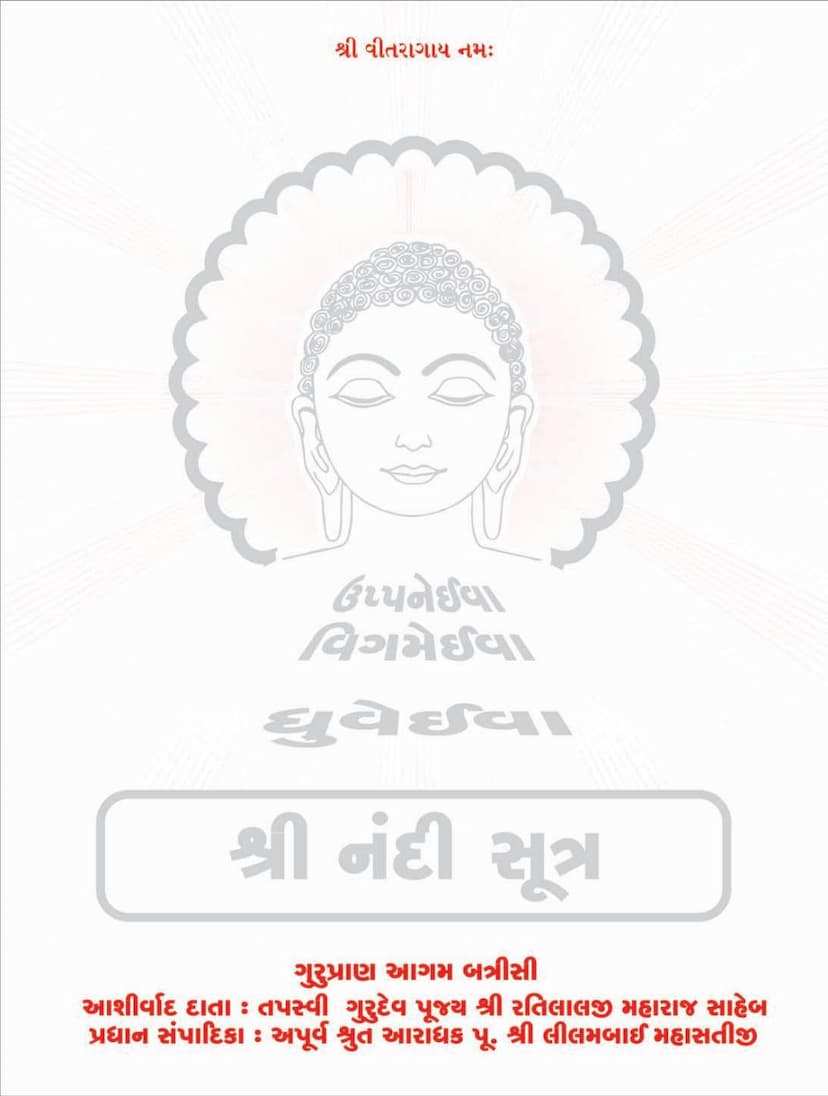Agam 31 Chulika 01 Nandi Sutra Sthanakvasi
Added to library: September 1, 2025

Summary
This Jain text, titled "Agam 31 Chulika 01 Nandi Sutra Sthanakvasi," is a commentary and translation of the Nandi Sutra, a foundational text in Jainism. Authored by Prankunvarbai Mahasati, Artibai Mahasati, and Subodhikabai Mahasati, and published by Guru Pran Prakashan Mumbai, it is part of a larger series called "Gurupran Agam Batrisi."
The text begins with traditional Jain salutations and dedications, honoring various revered ascetics and gurus, particularly those from the Gondal Gachh (sect). It expresses gratitude and remembrance for the spiritual lineage of Gurudev Shri Pranalalji M. Sa. and Gurudev Shri Ratilalji M. Sa., whose birth centenary and mahaprayan (passing) anniversaries are commemorated by this publication.
The book itself is a comprehensive work that includes:
- Mool Path (Original Text): The original Jain scripture in its canonical form.
- Shabdarth (Word Meanings): Explanations of the literal meanings of individual words.
- Bhavarth (Essence/Spirit): The deeper philosophical and spiritual meaning conveyed by the text.
- Vivechan (Commentary/Analysis): Detailed explanations and interpretations of the sutra's teachings.
- Parishisht (Appendices): Supplementary sections that provide further context and information.
The catalog link provided (https://jainqq.org/explore/008781/1) refers to JainQQ.org, an online platform for Jain literature.
Key Themes and Content:
The Nandi Sutra is primarily known for its profound discussion on Jain epistemology, specifically focusing on the different types of knowledge (Jnan). The text details the classification of knowledge into:
-
Paryaksh Jnan (Imperfect Knowledge):
- Mati Jnan (Sensory and Mental Knowledge): This is further broken down into various categories based on the senses involved (shrotendriya, chakshurindriya, etc.) and the quality of the knowledge itself (e.g., Rujumati, Vipulmati). The text delves into the nuances of how knowledge is acquired through perception, inference, memory, and other cognitive processes.
- Shrut Jnan (Scriptural Knowledge): Knowledge gained through listening to the teachings of the Tirthankaras and their disciples, as preserved in the scriptures. The text categorizes Shruta Jnan into various types like Akshar Shrut, Anakshar Shrut, etc.
-
Apratyaksh Jnan (Perfect Knowledge):
- Avadhi Jnan (Telescopic/ Clairvoyant Knowledge): Knowledge of subtle forms and events across space and time, but with limitations.
- Manahparyav Jnan (Telepathic Knowledge): Knowledge of the thoughts of other beings.
- Keval Jnan (Omniscience): The highest and most perfect form of knowledge, possessed by the Tirthankaras and Siddhas, which encompasses all realities in their entirety.
Structure and Content Overview from the provided pages:
- Introduction and Salutations (Pages 1-12): These pages introduce the text, express reverence for spiritual masters, and set the stage for the profound philosophical discussions. There are also dedications and acknowledgments, including those to the "Pran Parivar." The essence of the book is to make the Agamic literature accessible.
- Biographical Information (Pages 17-23): This section provides biographical sketches of significant spiritual leaders like Gurudev Shri Dungarsinhji M. Sa., Gurudev Shri Pranalalji M. Sa., and Gurudev Shri Ratilalji M. Sa., highlighting their contributions and virtues.
- The Core of the Nandi Sutra (Pages 27-41): This section, particularly the "Abhigam" (Approach) and "Sampadkiya" (Editorial) sections by Pujya Jayantmuni M. Sa. and Pujya Lilambai M. Sa. respectively, begins to delve into the content of the Nandi Sutra. It discusses the significance of the Nandi Sutra as a "mirror" to Jain philosophy and its focus on the five types of knowledge. The importance of the Sangha (community) is also highlighted.
- Detailed Explanation of Knowledge (Pages 42-53): This part of the text elaborates on the five types of knowledge, delving into the classification of Moti Jnan (Avagraha, Ila, Avay, Dharana) and Shruta Jnan. It also touches upon the subtle mathematical and cosmological concepts within the Agamas, as interpreted through the lens of Ganitanuyoga.
- The Nandi Sutra's Structure and Significance (Pages 51-53): This section reiterates that the Nandi Sutra's primary subject is the five types of Jnan and its unique stylistic approach of defining concepts through their subdivisions. It emphasizes the importance of the text as a foundation for understanding other Agamas.
- Concluding Remarks and Dedications (Pages 54-61): These pages include acknowledgments of supporters, patrons, and contributors to the publication, concluding with the publisher's information. The text also includes the "32 Swadhyay" section, listing various circumstances of impurity (Aswadhyaya) related to scripture study, which is crucial for Jain practice.
Overall Purpose:
This publication aims to make the profound knowledge contained in the Nandi Sutra accessible to a wider audience, particularly the Gujarati-speaking Jain community. It serves as a guide to understanding Jain epistemology, emphasizing the path to liberation through right knowledge, right faith, and right conduct as expounded in the Agamas. The text also acts as a tribute to the spiritual masters who have preserved and propagated this sacred knowledge.
The title "Sthanakvasi" indicates that this commentary is likely aligned with the practices and interpretations of the Sthanakvasi Jain tradition, which emphasizes scriptural study and asceticism.